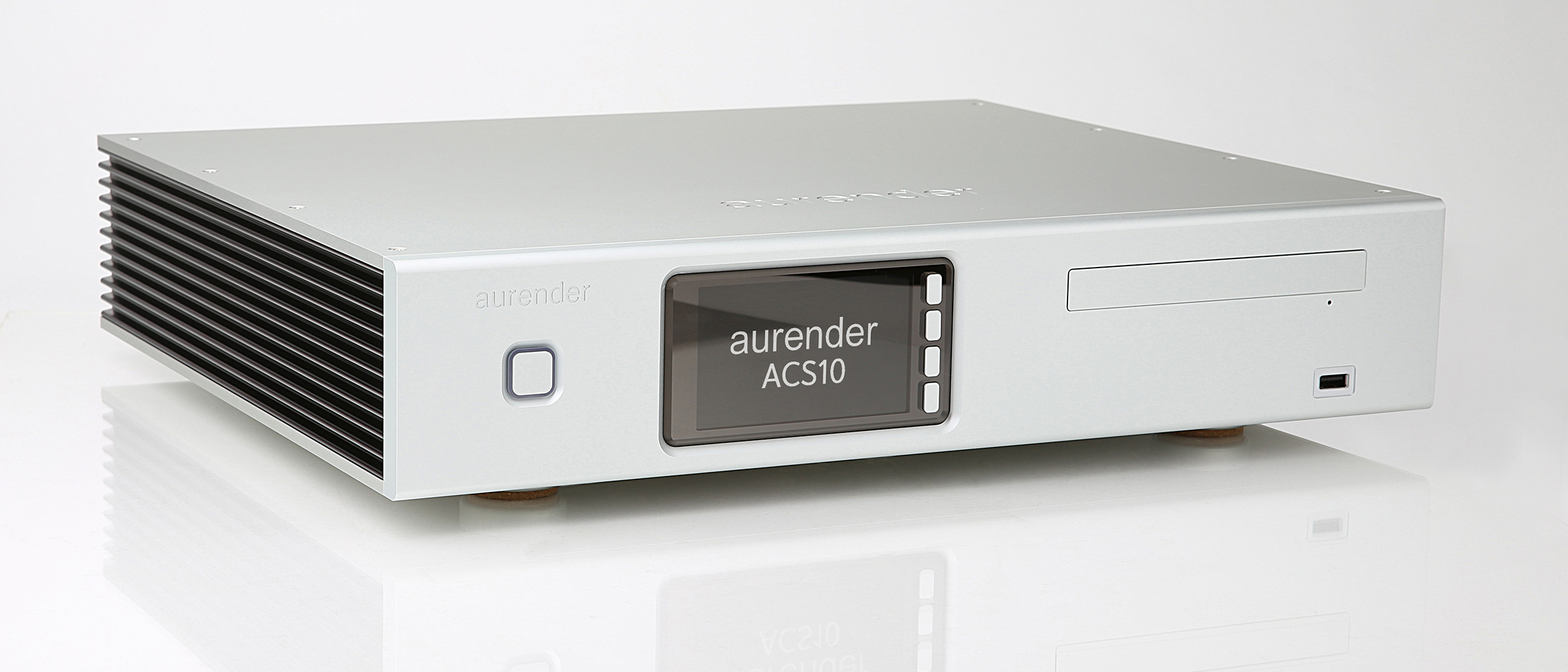What Hi-Fi? Verdict
The ACS10 from Aurender is an incredibly powerful unit for managing and safely storing your media collection, and while some limitations make it a little fussy to begin with, it's well worth the time investment.
Pros
- +
Enormous capacity
- +
Fast, smooth performance
- +
Control via iPad
Cons
- -
iPad required
- -
USB noise
- -
Limited DAC output settings
Why you can trust What Hi-Fi?

This review and test originally appeared in Australian Hi-Fi magazine, one of What Hi-Fi?’s sister titles from Down Under. Click here for more information about Australian Hi-Fi, including links to buy individual digital editions and details on how to subscribe.
We’re writing this introduction still in considerable ignorance about how to fully use the Aurender ACS10.
We do know that it is a very capacious music server and that it also has some online music streaming capabilities, but a full exploration of those capabilities is on hold because we’re watching the Windows 10 copy dialogue on this very computer saying that there’s three and a half hours to go before the copying is complete.
What are we copying? Close to a terabyte of music. We’re copying that music – or, rather, those music files – from a NAS to the Aurender ACS10.
Given that Windows advice, and the fact that it’s quite late at night, it looks like we’ll have to wait until tomorrow before we can start listening... but wait! It maybe the day after that, because Windows is now telling us that the transfer will take ‘more than a day’!
Equipment
We’ve kind of hinted at what the Aurender ACS10 is. It is a network audio server. It has a huge amount of storage, a CD tray to rip discs, and network and USB connections to allow the easy addition of music that is already available on your network.
The unit is component width as well as fairly tall and deep. It’s also extremely solid, weighing a daunting 12 kilograms (and measuring 430mm wide by 96mm tall by 355mm deep).
Prominent on the front panel is a 100mm IPS LCD display. This is colour, but most of the time is in light-blue-on-black mode for showing music and other information. The display is not touch-sensitive.
The latest hi-fi, home cinema and tech news, reviews, buying advice and deals, direct to your inbox.
There is a column of four control buttons to its right. Their functions are context-sensitive and because of this are displayed next to them on the screen. In the normal playback mode, three are for play/pause, skip back and skip forwards.
The topmost one changes the display function. To the left is a large button, a square with rounded corners and a white back-lit edge. That’s the symbol for Aurender and the icon used by the Aurender app.
To the right of the display is a CD drive. This is for ripping audio CDs to the internal disk.Inside our Aurender ACS10 were two hard drives, each 8TB in size. The unit is configured in a basic RAID format, which means each disk backs up the other, halving capacity, so the total capacity is 8TB.
We won’t bother to work out what that means in terms of playing time but let’s just say that even if you’re one of those few audiophiles with a healthy collection of space-hungry DSD files, there should be ample space for your full collection on the Aurender ACS10... but if not, the two discs can be reconfigured to non-RAID, which trades off some security for a doubling of space to 16TB. Other hard drive options are available, but it’s difficult to determine whether the size offered is the actual capacity in the RAID or the non-RAID configuration.
There’s also a USB socket on the front for connecting an external drive, plus one on the back for the same purpose or to provide power, perhaps for an iPad.
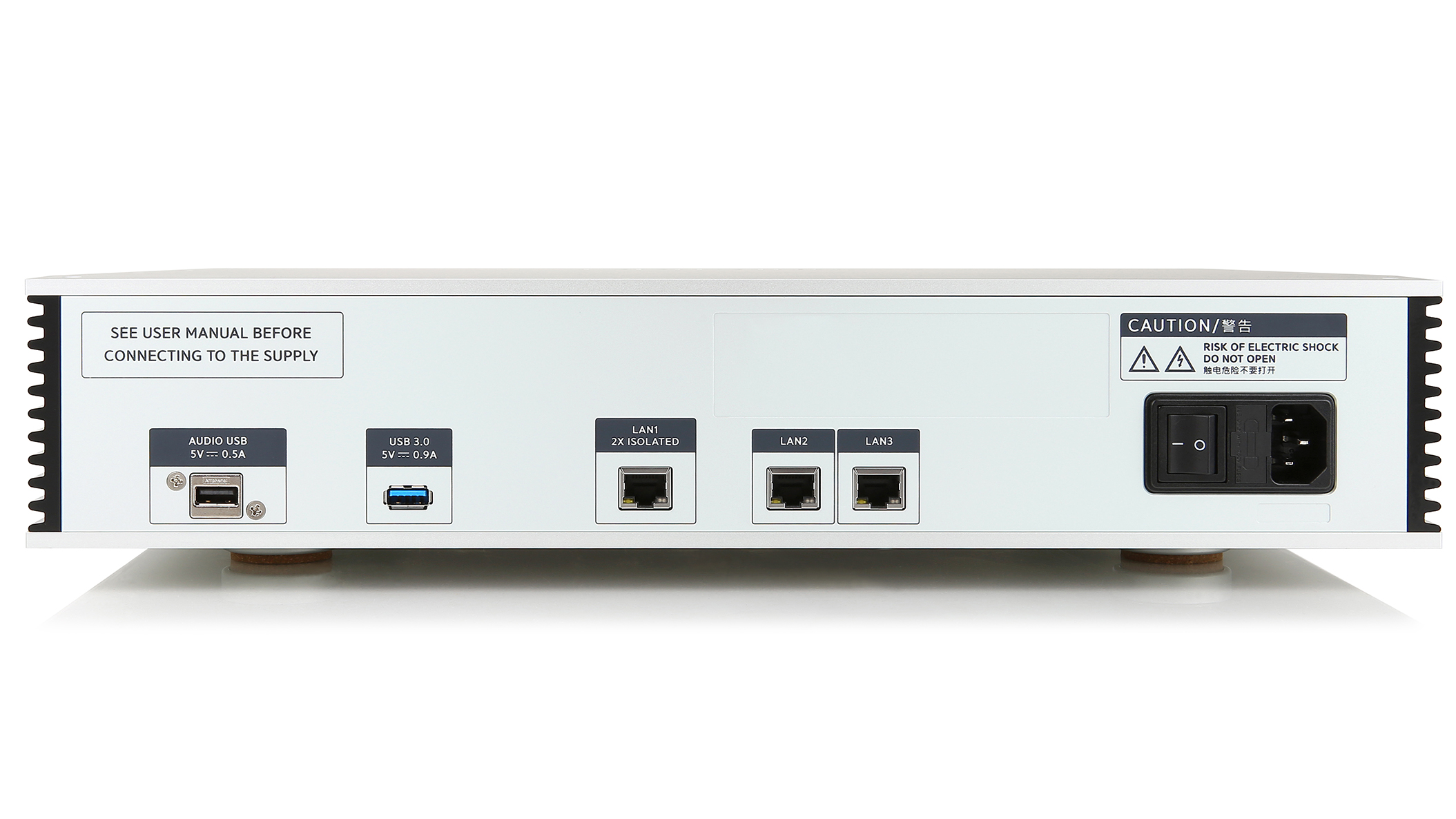
Also on the back is a USB socket dedicated to output to a USB DAC. Aurender says that it is a ‘filtered and isolated USB Audio 2.0 port dedicated for pristine audio’. Which is a good time to make it perfectly clear to anyone wanting to buy one that the Aurender ACS10 is a digital-only device. It has no analogue outputs.
Also on the back are three Ethernet ports, one of them labelled ‘2xIsolated’. You can use any of them to connect to your home network – there is no Wi-Fi – and the device acts as a network switch, allowing two other devices to be connected.
All three Ethernet ports are gigabit rated, which is ten times faster than older Ethernet connections. That makes for fast file transfers – expect something like two uncompressed CD-quality tracks per second and even faster for compressed files. There can be no cheating here: you must have the Aurender ACS10 connected to your home network or it won’t work.
If the five buttons on the front panel strikes you as insufficient to enable proper control over such a sophisticated device, you’d be right. You operate the unit with an app on an iPad or an iPad Mini: You cannot use an iPhone or an Android device.
Setting up
Because the network connection is Ethernet only, it’s simply a matter of plugging in. Well not quite, because the instructions are… well, let’s leave it at ‘very limited’. And it’s not helped at all by the claim that "further information is available at http://support.aurender.com/".
That address returns a ‘404 Error, page not found’ and seems to be quite defunct, because even clicking on the ‘click here to be redirected to the homepage’ link didn’t work.
That error we didn’t much like seeing, because although some hi-fi people revel in the intricacies of modern digital audio technology, most, we reckon, simply want the quality and convenience it offers without having to be bothered by troubleshooting silly things like dead web links.
Bascially, there should be a decent manual inside the box of any device that’s selling for nearly ten thousand dollars. And if it’s one of those skimpy ‘Quick Start’ manuals, it should refer to you a decent manual online, not to some dead link. And if a printed manual is too difficult or too costly, what’s wrong with supplying the manual on a USB stick?
We did manage to dig around the Aurender website and find some useful information, and it was this information which allowed us to work out how to connect the device to a computer as a network drive. Once we did that we could drag in the near-terabyte of music mentioned in my introduction to this review.
We may seem a little negative here about the Aurender’s user-friendliness, but we do think it is incumbent on a maker of network digital audio equipment to do two things: provide a bit of hand-holding for those who are uncertain in the field, and provide super-solid reliability in connections and operations.
Aurender may be pretty weak on the hand-holding, but it’s unimpeachable on the reliability side of things. Once we had worked out how to do something, it then worked first time, every time, with no worrying hesitations.
And it turned out that the Aurender ASC10 had all kinds of useful, often overlooked, features. For example, in the ‘Advanced’ section of the settings in the app you can set a ‘Playback delay to allow the DAC to adjust to new sample rate’. You can set that delay to between zero and ten seconds.
A feature like that is obviously the work of someone who has real-world experience with assorted DACs, some of which grab the incoming signal immediately, while otheres think about things for a while before letting the music start a few syllables into the song.
Ripping
It has been quite a few years since we ripped our CD collection. It presently resides on (coincidentally) 8TB of RAID-protected Network Attached Storage (but one that uses four 3TB discs and a more advanced RAID configuration.) Almost all the files are in FLAC format and the collection includes tracks with sampling of up to 384kHz, plus a moderately large chunk of DSD64, along with some DSD128 and DS256.
We copied the whole lot over but anyone new to this stuff may want to use the ripping feature. That turned out to be incredibly easy. You press the screen-switch button to go to the ripping page, then press the eject button to open the disc tray.
Pop in a CD and push the tray in a little. In the case of the 51-minute-long CD ‘Triptych’ by The Tea Party, four minutes and forty seconds later the tray opened again with the rip completed.
The unit goes off somewhere into the Internet to grab artist, track and album information along with cover art so the tracks are appropriately labelled. (In normal use the ACS10 does not show the cover art on its display, but it does feed it to the app.)
Exploring the contents of the Aurender via our network, we found that it uses the uncompressed WAV format for these rips.The ripping itself is performed by CUERipper v2.1.6 software.
You can drill in and inspect the logs. For some reason the discs we ripped didn’t match the AccurateRip checksums, even though the software reported the rip quality at 100 per cent. It may be that our discs were Australian versions and the comparison ones were from overseas.
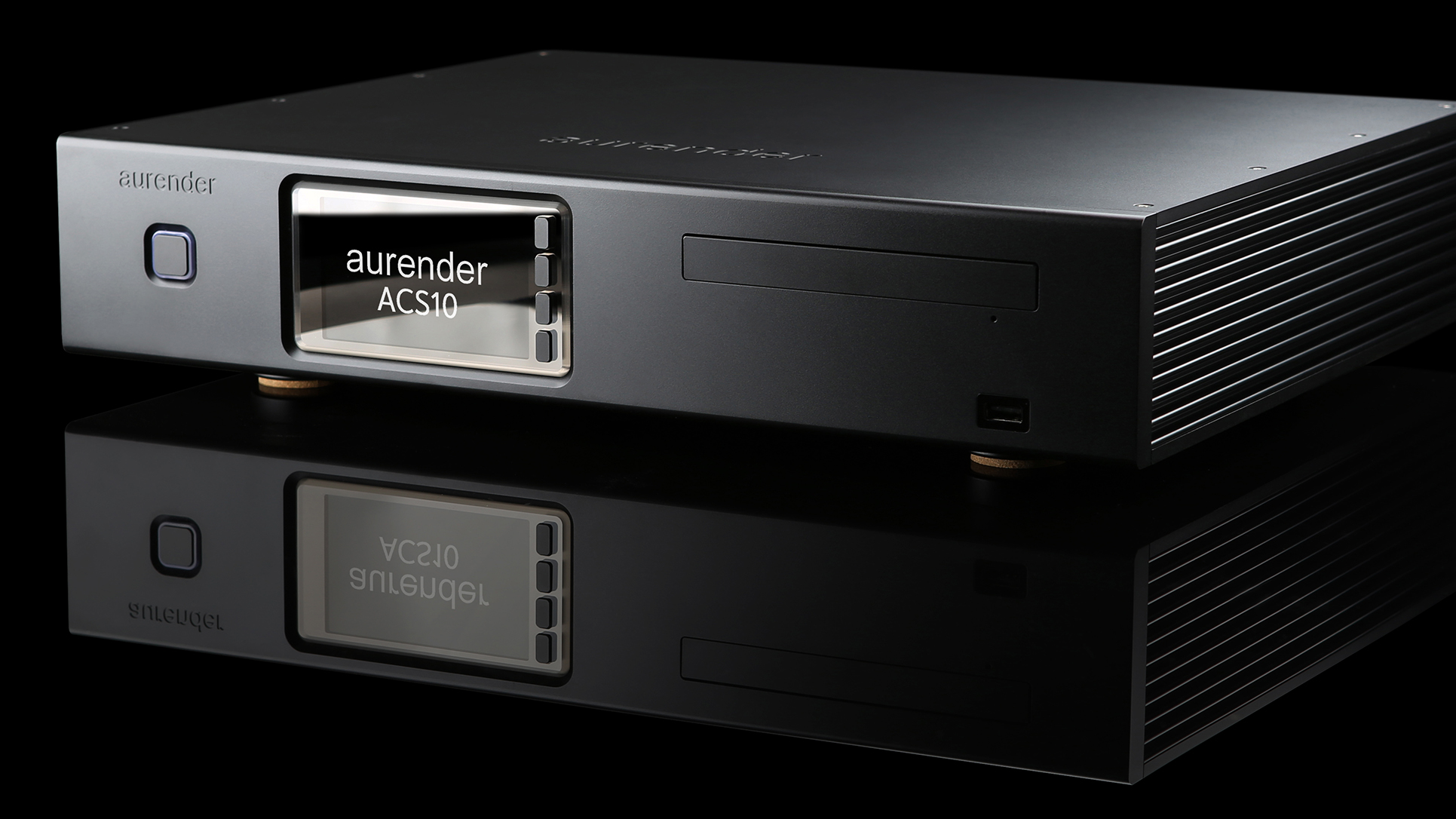
Choosing your DAC
The Aurender ACS10 does not have a volume control. Now you might say, ‘Well duh, it outputs a digital signal so of course it doesn’t’. Yes. Nonetheless, many DACs implement a volume adjustment which can be controlled by the source device. This doesn’t allow you to exercise that control.
If you’re using the Aurender ACS10 to ultimately feed a regular hi-fi system, this ought not to matter. You’ll want the two-ish volt output from the DAC for your system’s line input and you’ll just turn your usual volume control knob.
But if you want to listen with a DAC/headphone amp combo, then you’ll need to make sure the DAC has a physical volume control.
We raise this because one of the DACs we had to hand was an AudioQuest DragonFly Cobalt DAC. Using it was a little unfair since the Cobalt is intended for portable use with computers and smart phones which can, indeed, control its volume level. But line level output should have been fine and it measures very well, so why not?
The Cobalt’s output is fixed, of course, when it was plugged into the Aurender. But interestingly, its output was much, much lower than when it was plugged into a computer. How much lower? Exactly 20dB. The Cobalt delivered 2.05 volts output into an (effectively) open circuit when playing from a computer, but only 0.205 volts when playing from the Aurender ACS10.
We also tried the Sound Blaster G6 USB DAC, that company’s latest premium model. Its physical volume control didn’t work, which didn’t greatly surprise us. We think it works by sending a command back to its controller software on the computer into which it assumes that it is plugged, and that software then adjusts the volume. But no controller software meant no effect. It also was enormously lower in level.
That result suggests that either the Aurender issues a digital level command telling DACs plugged into it to keep to a modest level, or devices such as the DragonFly default to a – 20dB output setting for safety if they’re plugged into something which doesn’t issue a level command. Both are wise safety moves since if they defaulted to full level, they could damage one’s hearing and/or equipment.
This 20dB output drop affected neither of another couple of DACs we had to hand, (an old SilverStone EB01-E DAC and a Cambridge Audio DACMagic 100) neither of which has a proper headphone amplifier built in: they simply delivered their full output of 2.03 and 2.0 volts respectively.
Note that in each case the front panel display of the Aurender ACS10 showed the name of the DAC and information about the signal it was delivering. For example, the top line reads, as we’re writing this, ‘Async 96kHz Cambridge Audio DAC100 USB’ so it’s showing the name of the DAC and that the track that’s playing has a 96kHz sampling rate (a figure switches to whatever the sampling frequency is of the track that’s playing).
However, the information transfer didn’t always work perfectly. For example, when I played a 192kHz-sampled track to the DACMagic, the unit output it at 96kHz, even though the DACMagic handles everything up to 192kHz. Another DAC with 384kHz capability appears to have miscommunicated something, for the Aurender tried to feed it all music at 768kHz sampling… which it couldn’t handle, so no music at all came out.
The DAC we regularly use is generally well-behaved, and with it the Aurender delivered the native signal properly, whether it was 44.1kHz, 48kHz, 88.2kHz, 96kHz, 176.4kHz, 192kHz, 352.8kHz or 384kHz sampled PCM, or regular, double-speed or quad-speed DSD.
All of which is to say: if you already have a DAC, take it with you when you audition the Aurender ACS10 to make sure there are not going to be any unexpected complications.
In use
Despite that ‘more than a day’ warning from Windows 10 mentioned in the introduction, it turned out that the entire copying process only took a few hours, after which we were able to see that the internal storage of the Aurender ACS10 had 1,005GB occupied, and a further 6,312GB remaining free.
Once all the content was in the unit – and it really didn’t take very long, considering the quantity of data involved – using the Aurender was easy. Remember, you are doing everything via the iPad app.
We started with a very old iPad Mini to control the Aurender, but the App’s control panel is really pretty busy so the screen size of the iPad Mini made the app hard to use. So we switched to using a 2018 iPad with a 9.7 inch screen. The larger screen was still pretty busy, but it was far more controllable.
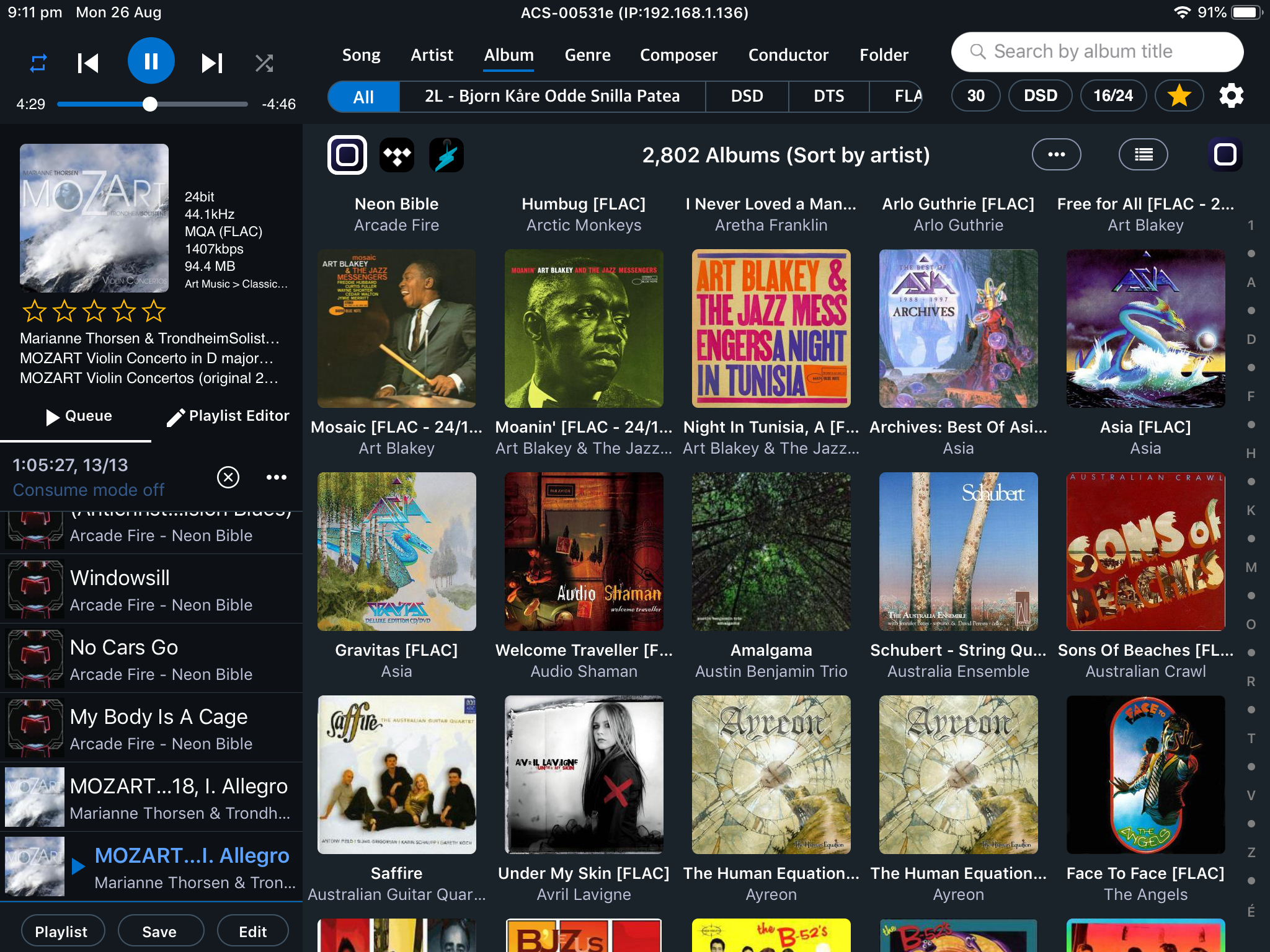
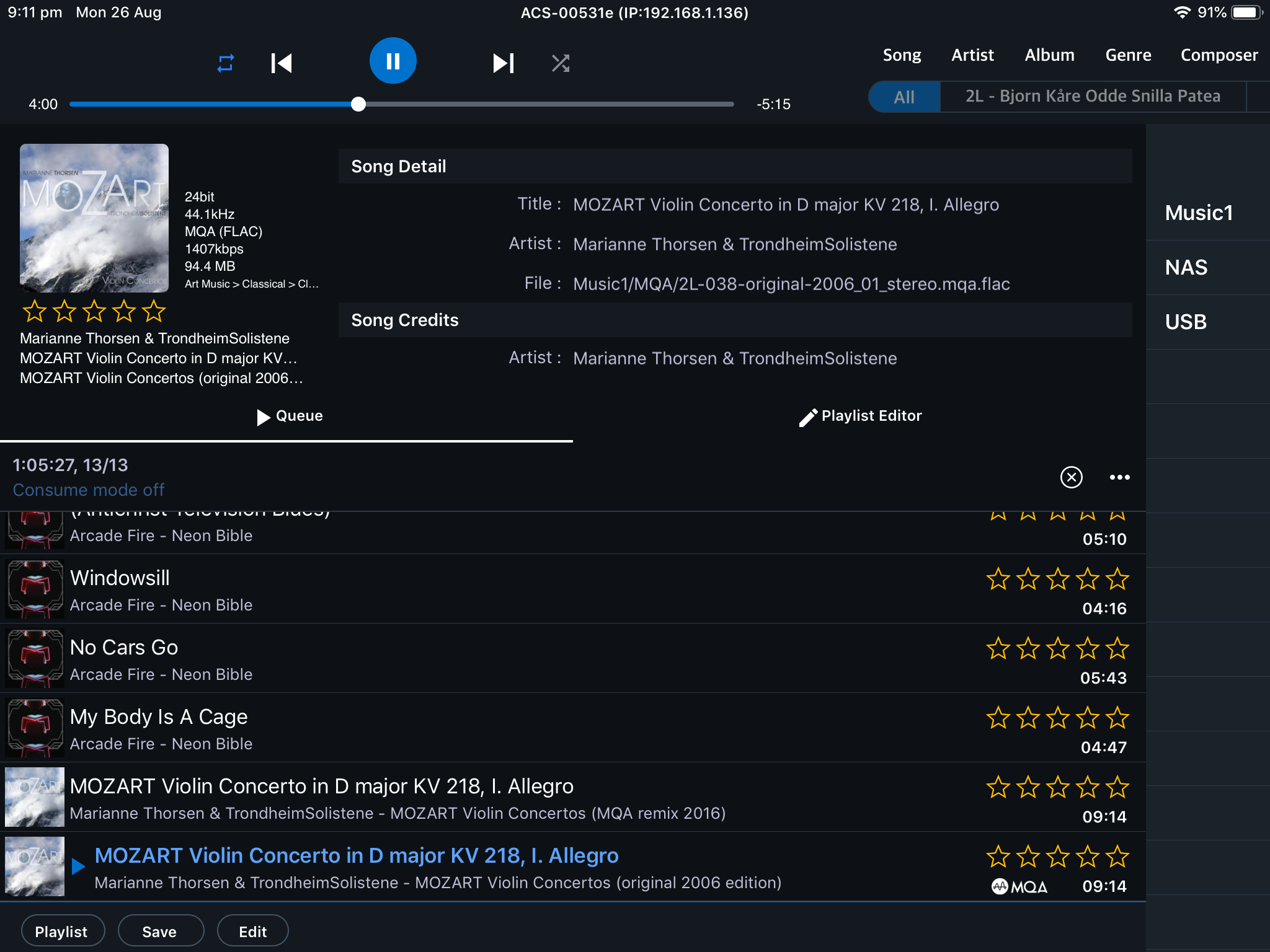
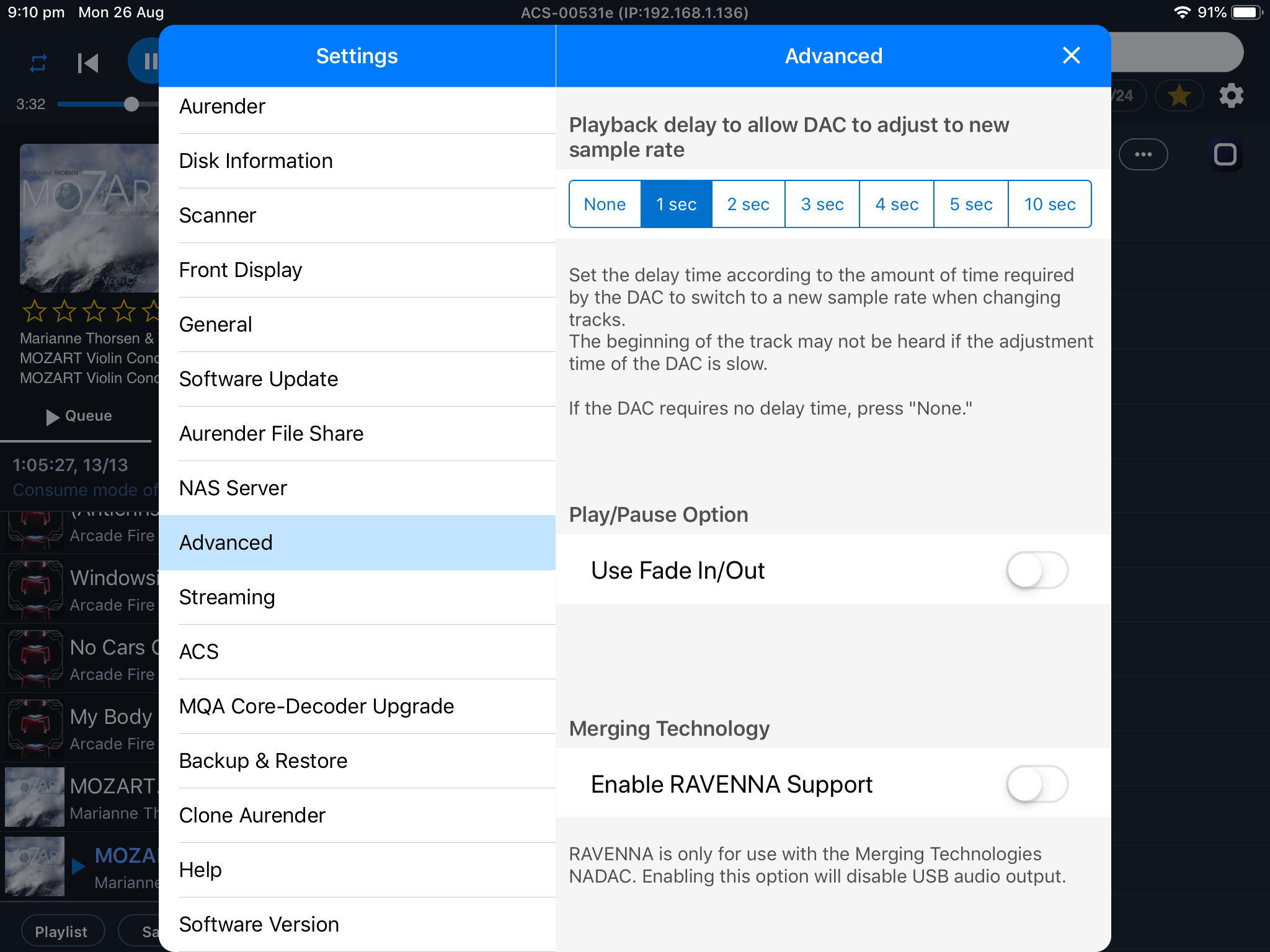
The Aurender ACS10 handles pretty much all file formats. We tested only up to 24-bits and 384kHz and DSD256 but Aurender says that it will go to 32-bits and 768kHz and up to DSD512 and we have no reason to disbelieve that.
The Aurender ACS10 also incorporates an MQA decoder.
Our DAC confirmed it was receiving, with suitable tracks, authenticated, unpacked 352.8kHz MQA material. It certainly sounded fine, although audio quality is determined more by the DAC and the other downstream equipment than it is by the digital source.
What we can say with confidence is that there was never once the slightest hesitation in music delivery. And this was most likely because whereas most network audio devices are principally computing tplatforms diverted for audio use, the The Aurender ACS10 is an audio device specifically devoted to one task. It isn’t interrupted by other things.
Indeed, even though the main storage is on spinning magnetic platters, the unit also packs a 240GB solid state drive ‘for System and Cache’. So the operating software is there, but that wouldn’t take more than a few tens of GBs.
The rest of that solid-state storage holds the music ready for playback, so even if a hard drive decides to do a bit of self-maintenance, your enjoyment won’t be impacted.
There is a built-in web page, accessible by typing in the unit’s IP address from any browser on your local network. But it doesn’t have much: just a picture of an Aurender server (not the ACS10) and a link to download the full track information file.
We downloaded it for the terabyte of stuff I’d put on, and the almost 5MB file had more than 30,000 lines, one for each track.
Lab tests
The Aurender ACS10 is an entirely digital product, so you might think that there really isn’t all that much to measure and you’d be right about that, but there was one thing that we thought might impact on real-world performance: noise.
As we all know, not all DACs are equal, and one way in which they are unequal is in their ability to keep noise delivered by the source device out of their analogue output.
We have noticed that when we’re testing a DAC with a computer connected, the A-weighted noise level can be as much as 14dB worse when the computer is plugged into power and, especially, when it’s also plugged into an Ethernet network.
It’s not surprise that network wiring, which connects dozens of disparate digital devices, should bring with it prodigious amounts of noise, but mains power noise should be a different story.
We were interested in the effect of the 2x isolated LAN connection provided by the Aurender ACS10. We used several DACs and compared the noise performance with each of them plugged into the Aurender ACS10 against a Surface Pro 2017.
The Aurender must be plugged into the network to operate – the iPad controller can’t tell it which tracks to play if it isn’t – but the Surface Pro, however, can be plugged in (via the dock), or electrically isolated, connected to the network via Wi-Fi.
It turned out that there was a tremendous difference to noise performance depending on which DAC we used in conjunction with the Aurender. We used two desktop DACs and two portable DACs. They delivered a noise performance of between – 108dBA and – 114.5dBA when used with the Surface Pro, running on battery and not plugged into the network.
When we plugged in the Surface Pro, the noise performance dropped for all four DACs. The range was from – 82.0dBA to – 114.2dBA. Clearly, one of them was very good at keeping out noise!
When we used the DACs with the Aurender ACS10, noise performance was from – 86.8dBA to – 110.9dBA, depending on the DAC. Why would that be? Clearly there was some noise coming from the ACS10 through to the various DACs. Some of them were better at keeping that noise out of their analogue output than others.
But where was the noise coming from? Could it just be that the 2x Isolation wasn’t as effective as we would have thought?
Or might there have been some other source of noise in the Aurender ACS10?
Either way, it’s a timely reminder that when you’re choosing a DAC – always, no matter what other equipment you’re using – choose one which does a good job at filtering out noise arriving over its USB connection.
We have presented the noise graphs on a per-DAC basis, showing each DAC with the Surface Pro 2017 both connected and not connected to Ethernet along with it connected to the Aurender ACS10.
The graph below shows the system noise floor with the Aurender ACS10 connected to a FIIO Q1M2 DAC (White Trace). Comparison server, Surface Pro 2017 with Ethernet (Green Trace) and with Wi-Fi (Blue Trace).
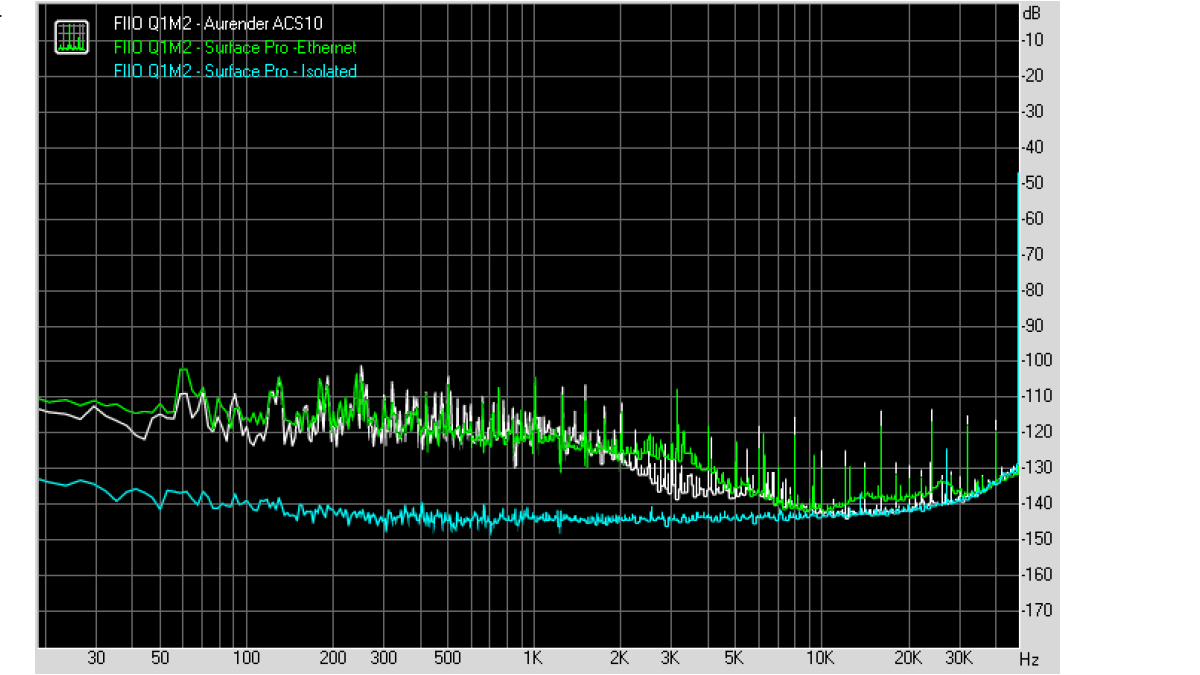
The graph below shows the same system noise measurements, but this time with the Aurender ACS10 connected to an Oppo HA2 DAC (White Trace). Comparison server, Surface Pro 2017 with Ethernet (Green Trace) and with Wi-Fi (Blue Trace).

The graph below shows the same system noise measurements, but this time with the Aurender ACS10 connected to a Silverstone EB01-E DAC (White Trace). Comparison server, Surface Pro 2017 with Ethernet (Green Trace) and with Wi-Fi (Blue Trace).

The graph below shows the same system noise measurements, but this time with the Aurender ACS10 connected to a Pro-Ject PreBox S2 DAC (White Trace). Comparison server, Surface Pro 2017 with Ethernet (Green Trace) and with Wi-Fi (Blue Trace).
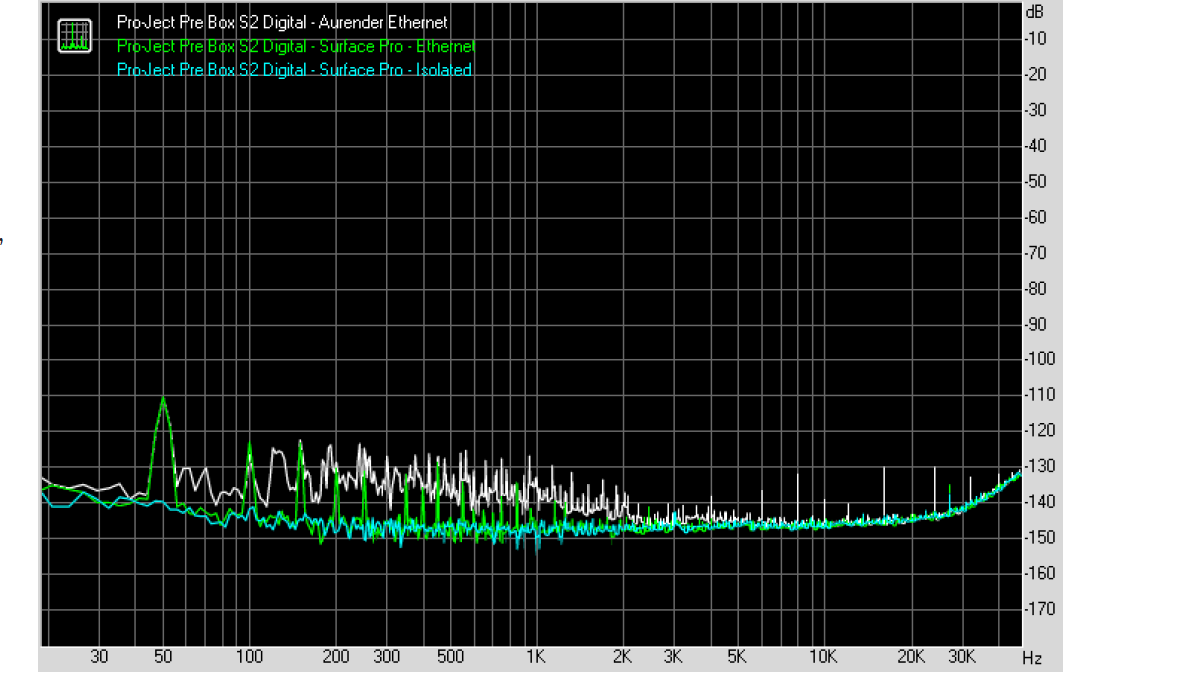
Final verdict
The Aurender ACS10 is an impressive feat of engineering with enormous capabilities and superb reliability. It’s even very easy to use… once you learn how. But you will need to exercise a lot of care when choosing the DAC you will use with it.
Australian Hi-Fi is one of What Hi-Fi?’s sister titles from Down Under and Australia’s longest-running and most successful hi-fi magazines, having been in continuous publication since 1969. Now edited by What Hi-Fi?'s Becky Roberts, every issue is packed with authoritative reviews of hi-fi equipment ranging from portables to state-of-the-art audiophile systems (and everything in between), information on new product launches, and ‘how-to’ articles to help you get the best quality sound for your home.
Click here for more information about Australian Hi-Fi, including links to buy individual digital editions and details on how best to subscribe.
